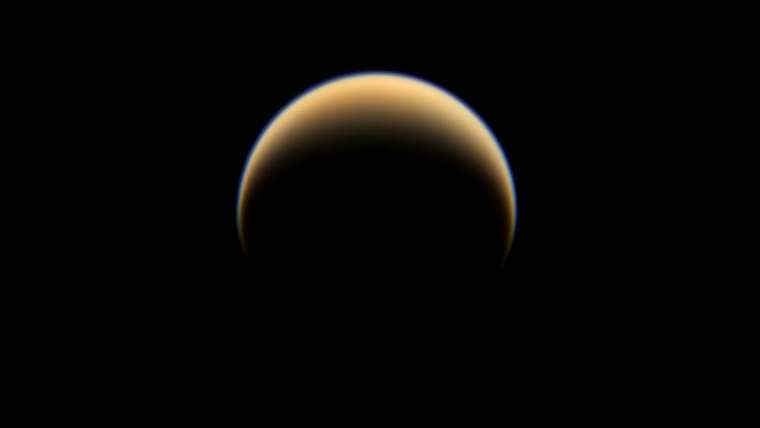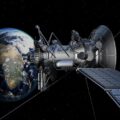Scientists have detected mysterious, gyroscopic motion within the atmosphere of Saturn’s moon Titan that appears to be completely independent from its surface rotation.
Scientists from the University of Bristol made the discovery while analyzing sensor data from the NASA-ESA Cassini-Huygens mission’s flyby of the Saturnian moon. The researchers say they cannot explain the mysterious motion, which seems connected to the moon’s seasons, each lasting several Earth years.
Titan has long fascinated scientists due to its similarities to Earth. Such features include its rocky surface, lakes and rivers of methane and ethane with ocean-like waves, and a thick, carbon-rich atmosphere (a rarity within the solar system).
The team behind the latest discovery says their findings join a growing body of research suggesting Titan is not just Earth-like in appearance, “but an alien world with climate systems all its own.”
Mysterious Gyroscopic Motion of the Atmosphere and Other Titan Mysteries
Launched as a joint venture between NASA and the ESA in 1997, the long-range Cassini-Huygens probe spent the final 13 years studying Saturn and its moons in the infrared spectrum. Although the spacecraft made its final transmission in 2017 before intentionally crashing into Saturn, scientists are still making regular discoveries by combing through the mission’s treasure trove of scientific data. Previously, scientists relied on the mission’s data to debate Titan’s past and present habitability and whether the moon could support life.
For the current study, the University of Bristol team focused on data measuring the symmetry of Titan’s atmospheric temperature field. A comparison between atmospheric and surface data showed that the atmosphere isn’t centered on the moon’s pole as was expected. Instead, the data revealed an atmospheric shift over time that appeared to be aligned with Titan’s seasonal cycle. The correlation was particularly pronounced since a year on Titan lasts nearly 30 Earth years.
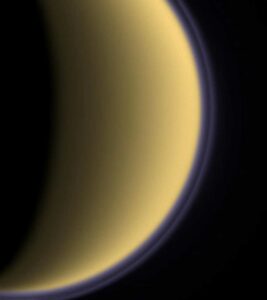 A false-color image of Titan captured in 2004 by the Cassini spacecraft. The purple haze shows the dense atmosphere enveloping the moon’s golden body. Credit: NASA/JPL/Space Science Institute.
A false-color image of Titan captured in 2004 by the Cassini spacecraft. The purple haze shows the dense atmosphere enveloping the moon’s golden body. Credit: NASA/JPL/Space Science Institute.
Further analysis of the Cassini-Huygens data revealed a noticeable tilt in Titan’s atmosphere. According to Lucy Wright, lead author of the study detailing the team’s research and a postdoctoral researcher at Bristol’s School of Earth Sciences, this finding was even more intriguing since the size of the atmospheric tilt “changes with Titan’s seasons.”
Although there is no immediate explanation for the atmosphere’s pronounced tilt, Wright believes some past event may have knocked the moon’s atmosphere off its spin axis, causing the entire thing to “wobble.” Whatever the cause, Titan now has an atmosphere moving in step with its seasons yet independent of its rotation, and a mysterious, gyroscopic motion scientists can’t easily explain.
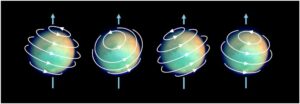 Titan’s atmosphere is tilted relative to its solid body, and this tilt varies in size and direction. Titan image credit: NASA/JPL/Space Science Institute. Diagram by Lucy Wright.
Titan’s atmosphere is tilted relative to its solid body, and this tilt varies in size and direction. Titan image credit: NASA/JPL/Space Science Institute. Diagram by Lucy Wright.
“The behaviour of Titan’s atmospheric tilt is very strange!” Wright said. “Titan’s atmosphere appears to be acting like a gyroscope, stabilising itself in space.”
Professor Nick Teanby, co-author and planetary scientist at the University of Bristol, agreed, noting that while the discovery answered one question, it ended up creating another: what caused the tilt in the first place?
“What’s puzzling is how the tilt direction remains fixed in space, rather than being influenced by the Sun or Saturn,” Teanby said. “That would’ve given us clues to the cause. Instead, we’ve got a new mystery on our hands.”
Have No Fear, NASA’s Dragonfly is (almost) Here!
Over the course of its mission, Cassini-Huygens captured a massive amount of scientific data that researchers will continue to analyze for decades. Dr Conor Nixon, a planetary scientist at NASA Goddard and co-author of the study, said these latest findings show that even after its fiery death, “there are still remarkable discoveries to be made in Cassini’s archive.”
“This instrument, partly built in the UK, journeyed across the Solar System and continues to give us valuable scientific returns,” he added.
While those future studies will likely inform several branches of science, the University of Bristol team believes that their insights into the atmospheric dynamics above Titan could soon be put to practical use on NASA’s upcoming Dragonfly mission. Currently scheduled to arrive on Titan sometime in the 2030s, Dragonfly is a drone-like rotorcraft that must survive the moon’s harsh winds and dense atmosphere.
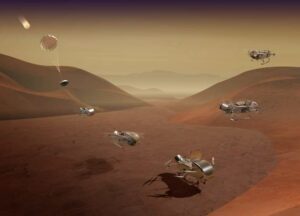 NASA’s planned Dragonfly mission will experience harsh winds during descent and flight (Image credit: NASA/Johns Hopkins APL/Steve Gribben).
NASA’s planned Dragonfly mission will experience harsh winds during descent and flight (Image credit: NASA/Johns Hopkins APL/Steve Gribben).
According to mission planners, the craft will be most vulnerable during its descent through the atmosphere, where it will try to navigate winds moving 20 times faster than the surface’s rotation. The University of Bristol research team says understanding the dynamics underlying the atmosphere’s mysterious, gyroscopic motion and its connection to the moon’s seasons will be “crucial” for calculating the Dragonfly mission’s landing trajectory.
“The [atmospheric] tilt affects how the payload will be carried through the air, so this research can help engineers better predict where it will touch down,” they explain.
Although future missions like Dragonfly will likely add crucial data to the mystery of Titan’s atmospheric wobble, the research team says understanding how the atmospheres of varying planets and moons behave is applicable to objects within our Solar System and beyond.
“The fact that Titan’s atmosphere behaves like a spinning top disconnected from its surface raises fascinating questions—not just for Titan, but for understanding atmospheric physics more broadly, including on Earth,” Nixon concluded.
Christopher Plain is a Science Fiction and Fantasy novelist and Head Science Writer at The Debrief. Follow and connect with him on X, learn about his books at plainfiction.com, or email him directly at christopher@thedebrief.org.
